Starter 401(k) Contribution Limits for 2024
In 2024, the IRS set specific contribution limits for Starter 401(k) plans at $6,000 with an additional $1,000 catch-up contribution for employees over the age of 50.
The IRS sets limits on retirement account contributions in order to regulate the tax advantages provided by these plans. These limits help ensure fairness by preventing those with higher incomes from receiving a disproportionately large share of tax benefits.
The IRS reviews these limits annually and makes adjustments based on factors like inflation. These changes aim to preserve the purchasing power of retirement savings and to keep pace with the cost of living. While the exact amount you can contribute may vary from year to year, the overall goal remains — to provide a balanced, fair system that encourages retirement savings for all income levels.
How to Max Out Your Starter 401(k) Contributions Limits in 2024
To max out your Starter 401(k) contributions for 2024, you need to contribute $6,000 throughout the year. Here's how you might do it:
Example 1: Under the age of 50
Assume you get paid twice a month, which is 24 pay periods in a year. To reach the $6,000 limit by the end of the year, you would need to contribute $250 from each paycheck ($6,000 ÷ 24 = $250). This way, by the end of the year, you would have contributed the maximum amount allowed to your Starter 401(k).
Example 2: 50 years or older
For individuals over the age of 50, the Starter 401(k) plan allows for an additional "catch-up" contribution. In 2024, this limit is set at $1,000. This means, in total, you could contribute up to $7,000 ($6,000 regular contribution + $1,000 catch-up contribution) to your Starter 401(k) for the year.
If you're paid twice a month (24 pay periods), you would need to contribute $291.66 per paycheck to invest $7,000 by the end of the year ($7,000 ÷ 24 ≈ $291.66).
These are simplistic examples, and your actual contributions may vary based on factors such as your income, other deductions, and your personal financial situation. Always consult with a financial advisor or tax professional to make the best decisions for your individual circumstances.
Benefits of Starting a 401(k) for Your Small Businesses
Starting a 401(k) plan for your small business offers numerous benefits, both for you as the business owner and for your employees. Here are a few advantages to consider:
- Tax Credits: Because of the Secure 2.0 Act, your business may receive up to $6,500 in tax credits for setting up a new retirement plan.
- Employee Retention and Recruitment: Offering a retirement savings plan can attract and retain talented employees. It demonstrates your commitment to their long-term financial well-being, as well as fosters loyalty and job satisfaction.
- Building Retirement Savings for Business Owners: As a small business owner, you can't forget to prioritize your own retirement savings. A Starter 401(k) plan allows you to build a nest egg that will offer financial security in your golden years.
- Reduced Taxable Income: With traditional 401(k) contribution plans, your pre-tax contributions reduce your taxable income. This can result in significant tax savings for both you and your employees.
Other 401(k) Retirement Plans for Small Business Owners
Safe Harbor 401(k): Safe Harbor 401(k) plans require employers to match employee contributions, but they also allow businesses to avoid annual IRS nondiscrimination testing, which reduces administrative burdens and potential correction issues. The 2024 contribution limit for this plan is $23,000 with an additional $7,500 catch-up contribution for those 50 years of age or older. This is Penelope's most popular plan type for businesses. Tell us about your business to get a plan recommendation!
Solo 401(k): Designed for self-employed individuals with no employees other than a spouse. It allows for higher contribution limits. In 2024, the limit is $69,000 with an additional $7,500 catch-up contribution for those 50 years of age or older. This plan is great for freelancers and independent contractors.
SIMPLE IRA: The Savings Incentive Match Plan for Employees (SIMPLE) IRA is a low-cost retirement option for small businesses with less than 100 employees. Similar to the Safe Harbor 401(k) plan, it requires employer contributions. In 2024, a SIMPLE IRA has a maximum contribution limit of $16,000 with a $3,500 catch-up contribution for those 50 or older.
Get Started with a Penelope Starter 401(k) Plan →
Planning for retirement is a big but important step for small business owners. By understanding the Starter 401(k) contribution limits for 2024 and implementing effective strategies, you can maximize your retirement savings. And offering retirement benefits will help you attract and retain top talent.
Remember, a secure retirement is within reach with careful planning and smart contributions. Start today and secure a brighter tomorrow for yourself and your employees. Not sure if the Starter 401(k) plan is what you're looking for? Get a retirement plan recommendation from our retirement specialists by telling us about your business.





